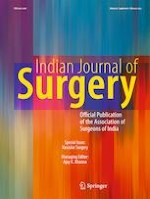14-08-2021 | Varicosis | Original Article
Bacteriological Study of Varicose Vein Specimens
Published in: Indian Journal of Surgery | Special Issue 1/2023
Login to get accessAbstract
Varicosity and chronic venous insufficiency (CVI) are thought to be due to reflux or pathologic retrograde flow caused by an incompetent venous valve leading to venous hypertension followed by reflux. A variety of factors have been postulated in association with varicose veins. Venous hypertension leading to reflux and varicosity may be associated with inflammation due to microbiological activity. This study was carried out with the objective that infection can be an etiological factor for varicose veins. A prospective study was carried out at a tertiary health care center from June 2014 to December 2020. A total of 100 patients with varicose veins (with 120 limb involvement) were recruited. Samples of normal leg veins were taken as control from 10 patients who were undergoing saphenous vein bypass grafting or amputated limb following road traffic accidents. We studied the primary varicose veins for microbiological etiology of the disease by culture studies of varicose veins and further confirmation by 16 s-rRNA PCR analysis. The sample of veins harvested during intervention was submitted for microbiological culture. Out of 42 cultures, Pseudomonas spp. in 6 cases (14.29%), Klebsiella spp. in 4 cases (9.52%), 2 cases (4.76%) each of Staphylococcus aureus and Proteus spp., and one case of Citrobacter on bacterial culture of truncal veins and on 16 s-rRNA PCR on DNA extracted from truncal varicose vein samples. Pseudomonas spp., Staphylococcus aureus, Klebsiella spp., Proteus spp., and Citrobacter spp. were detected in 10 cases (23.81%), 6 cases (14.29%), 5 cases (11.9%), 2 cases (4.76%), and 1 case (2.38%), respectively. In the ten specimens of normal vein, taken as control, 9 cases show no bacterial growth and 1 (10%) case shows a growth of micrococci. In consideration of the results of the present study, microbiological etiology of varicose veins is a distinct association which was confirmed in this study.





